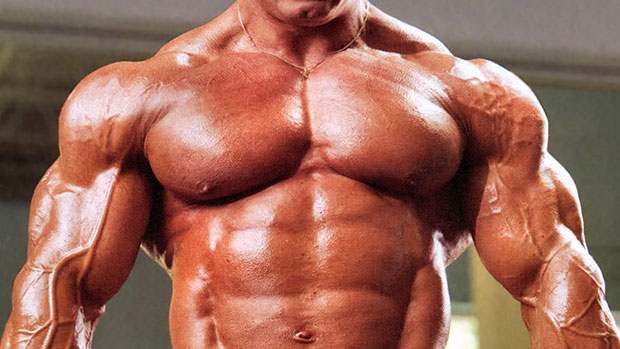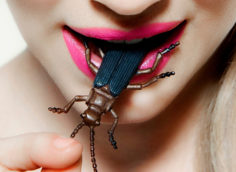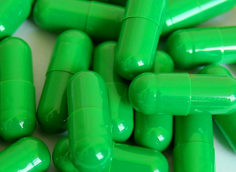Let's say we have two guys, Bart and Larry. They're both T-men, members of our tribe. They lift weights, they take supplements, and they try to manipulate their diets to achieve certain physique goals. In other words, they're our brothers in iron, so let's be respectful to them ... even though they're both fucking up.
To what end are they fucking up? Let's take a closer look:
Our buddy Larry wants to gain muscle, so he hits the gym hard. Problem is, his muscular gains stalled out shortly after he lost his newbie status. He wonders if he has pencil-neck genetics, and he secretly wishes his mom had stepped out on his father with that burly Samoan mailman they used to have. Maybe then he could put on some real size.
But genetics isn't the real problem. You see, Larry may not be all that muscular but he has a rockin' set of abs. Understandably, he doesn't want to lose them. So Lean Larry is basically always on a fat-loss diet. His calories are just way too low to support optimal muscle gains and reap the benefits of all that training.
Lean Larry knows he should be eating more to help him gain muscle, but he's just not willing to get fat to do it. And with his family's history of disease, he doesn't want to sacrifice his health. But damn it, he sure would like to look like he lifts weights when he's wearing a large T-shirt.
The solution? We'll get to that in a minute. First, let's meet Lean Larry's friend Bart, who's also fucking up, but in a different way.
Bart's no slouch in the gym either. Like Larry, he trains his ass off. Problem is, Bart's ass is so big it seems no amount of training could get rid of it.
See, Big Bart wants more muscle too. He knows that requires more than a maintenance level of calories, so he makes sure to eat plenty. But let's be honest here: every pimply-faced kid at every fast food drive-through in town knows Bart by name.
Bart wears an XXL T-shirt, but like Lean Larry, he doesn't really look like he lifts. He just looks like a fat guy with better than average traps. Sure, there's muscle under there, but you can't really see it.
And the last time Bart went to the doctor he didn't like what he heard. Bart wants more muscle, but he'd also like to see his kids graduate ... from kindergarten. And it would be nice to take his shirt off at the pool this summer without looking like he was about to give birth to triplets.
The solution for Big Bart? Believe it or not, it's the same as Lean Larry's: Consume clean foods, in the right amounts, for clean muscular gains.
Lean Larry seems to think that the only way to add big muscle is to eat so much that he adds big fat in the form of matching pairs of love handles and "moobs." Because of this belief, he restricts his diet so much that he can't put on even marginal amounts of muscle. He's lean, fit, and healthy – give him credit for that – but he's also failing to reach his goal of building bigger, stronger, more noticeable muscles.
Big Bart also thinks the only way to gain muscle is to overeat, so that's what he does. He's big and strong, but he's also fat and unhealthy. And, since bad nutritional habits tend to be addictive, he's seriously hooked on junk food.
Both of these guys are stuck on the idea of a "dirty bulk" – eating a gross excess of calories, many from unhealthy sources, in order to gain muscle. But the dirty bulk is a bad idea, especially now that the experts know a better way to do it.
Longtime Testosterone Muscle contributor Christian Thibaudeau is downright pissed off: "I'm tired of seeing young kids with good potential – who are lean and have nice shapes to start with – ruin their bodies by following the bulking advice from Internet 'gurus' who tell them to eat as much food as they can, even junk food. All this will accomplish is helping them add heaps of fat to their lean bodies."
"Somehow we've confused extra calories to build muscle with eating burgers and fries," says Alwyn Cosgrove. "We can't forget that the entire bodybuilding world came about as a pursuit of health. Bob Hoffman's original fitness magazine was called Strength and Health. Let's not lose sight of that."
Here are a few more reasons to skip the dirty bulk:
1 The premise is fundamentally flawed.
Do you need more than a maintenance level of calories to build muscle? Yes, everyone agrees on this point. Do you need thousands of excess calories? No.
Let's pull some theoretical numbers out of our collective ass, and say that Lean Larry needs 1,000 extra calories a day to gain muscle. He may add a small, acceptable amount of body fat doing this, but those 1,000 calories will give him plenty of energy for his workouts, plenty for recovery and tissue remodeling, and a little extra to account for the uptick in his metabolism caused by the training, excess calories, and increased muscle mass.
With those extra calories, Larry would be at what Thibaudeau calls the "limit rate" of muscle gain. That upper limit is the most lean tissue your body will add in any given amount of time, assuming this is new muscle mass we're talking about. (You can regain lost muscle on an accelerated schedule, but that doesn't apply to Larry.)
Now let's say Lean Larry has an identical twin named Gary, with identical training experience and goals. We're going to give him an extra 3,000 calories a day, a lot of it from junk food. In other words, Gary gets the dirty bulk. Is he going to add three times as much muscle as his brother?
No.
Charles Poliquin puts it like this: "Bulking-up diet programs won't produce any more muscle growth than ingesting an ideal amount of nutrients. Sorry, but it's simply not possible to force additional muscle growth by overfeeding."
Thus, Gary builds the same amount of muscle as Larry, while adding a lot more fat. But there's even more bad news for Gary.
2 The dirty bulk leads to a downward spiral of damaged health and, ultimately, lifelong fatness.
How? For starters, it can make you more insulin resistant, just as it does to the typical couch spud. Poliquin points out that this makes it harder to gain muscle in the long run, since carbohydrates get stored preferentially as fat, rather than being used for energy and to fuel muscle growth.
The problem multiplies if you do a series of dirty bulks without losing the fat in the interim. "The fatter you get, the harder it becomes to get lean," Poliquin says.
Thibaudeau echoes Poliquin's concern. "The more fat cells you have, the easier it is for your body to store fat. And when overeating for a significant period of time, your body increases its number of fat cells, which are impossible to remove without surgery. By adding new fat cells to your body, you're actually making it better at gaining body fat, and worse at losing it."
If you think about it, the constant bulk/cut cycle, when taken to extremes, is the same thing as a yo-yo diet, which we know is very damaging.
"Bodybuilders are just as likely to suffer from the metabolic effects of frequent weight fluctuations," says Lonnie Lowery, Ph.D., R.D., an assistant professor at the University of Akron. "The list of nasty side effects is long: thyroid suppression, leptin suppression, muscle loss, depressed metabolism of about 10 to 15 percent, increased lipoprotein lipase activity and fatty acid synthase function, and exaggerated insulin action. Add to that the very real concept that yo-yo dieting 'awakens' fat cells that were previously non-functioning, and you've got yourself one hefty case of metabolic damage."
Then there's this charming, if extreme, possibility: "The fatter you get, the more aromatase enzyme your body will produce," Poliquin warns. "In the extreme, getting fat could be considered a form of self-castration, as your own Testosterone will be converted into the female hormone estrogen. If you're a man and you enjoy wearing a bra, go right ahead and get fatter."
3 The dirty bulk is hard to kick.
Sports psychologist Jack Singer, Ph.D., tells us that it takes about 21 days of going cold turkey to defeat a bad habit or ingrained pattern of behavior.
But it's hard to say how long it takes for a negative habit to develop. In my experience and observations, it might take less time to fall into an unhealthy pattern of behavior than it takes to break out of it.
A dirty bulk starts with two intentions: You'll eat a ton of calories, gaining fat along with muscle. Then you'll lose the fat while keeping the muscle.
Unfortunately, the first intention is much easier to act upon than the second. Not only are you dealing with the biological changes that favor future fat gain and prevent fat loss, you're also dealing with psychological obstacles, and perhaps even neurological changes that mirror the hallmarks of substance addiction.
Bart Hoebel, Ph.D., a Princeton University psychology professor, has shown in his recent studies that rats allowed to binge on sugar showed signs of actual chemical dependency, with neural changes to their opioid receptors. In a study published in 2002, the rats even showed classic signs of drug withdrawal, such as chattering teeth and shivering, after the sugar was pulled from their diets.
Alain Dagher, M.D., and colleagues from the Montreal Neurological Institute also found that ghrelin, the appetite hormone, worked on regions of the brain involved with reward and motivation. These are the exact same regions implicated in drug addiction. In fact, cocaine and nicotine can affect the same areas of the brain as junk food.
And it's not just sugar: Researchers at the University of Wisconsin-Madison found in a 1998 study that a high-fat diet alters brain chemistry in a similar way to drugs like morphine. Again, those pesky opioids are involved, in this case reducing the feeling of being full.
"Overeating triggers overeating," says Jonny Bowden, Ph.D. "Overeating can actually stimulate a metabolic response in the brain that induces cravings to eat more. These excess calories upset and inflame metabolic processes that underlie disease." Result? "A vicious cycle of elevated calorie consumption that can lead to obesity, diabetes, and insulin resistance."
Let's simplify all this even more: When you allow yourself to acquire bad habits in a dirty bulk, you risk changes in brain chemistry very similar to those seen in drug addicts. It's like playing with matches in an open field in the middle of a drought.
"Okay, Mr. Hawt-Abz McHealthypants," you might ask, "how do I take in just the right amount of excess calories using only clean foods?"
Good question. Actually, two good questions:
- How many calories do you need?
- How do you get them with clean, health-promoting foods?
To figure out the answer, I studied at least a half-dozen calorie-calculating systems. At the simple end, you might not need to take into account anything more complex than your weight and body-fat percentage. At the other end, you'd end up calculating everything from your age, gender, activity level, lean body mass, and astrological sign.
And you know what? They're all crapshoots, educated guesses that give you a starting point but no clear and foolproof route to your destination. But I did find a general pattern in their assumptions and methodology. Here, I think, is what just about everyone can agree on regarding muscle gain:
Eat 800 to 1,000 calories a day over your personal maintenance level.
This should be plenty to increase muscle size without bulking up your waist size. And if you do find yourself with some mid-body spillover, you can easily adjust your calories downward or your workout volume upward to nip it in the bud.
But now we get to a third question – or, more accurately, the precursor to the first question: How do you calculate your maintenance level?
I don't know. My crystal ball is in the shop. But if you've weighed about the same for at least six months, never fluctuating by more than a few pounds, you can assume that's your maintenance level. So, just to pick some numbers, let's say you're training hard and eating as well as you can, and your weight has stayed between 178 and 182. Whatever your current calorie intake is, we can safely guess it's your maintenance level.
Add 800 to 1,000 calories a day, and see what happens for four to eight weeks. Add more calories if you don't gain any muscular weight. If you gain solid weight with no evident ill effects, stay at that level. If you gain a combination of muscle and fat, adjust the additional calories downward. And if you gain fat without adding any muscle, get a new workout program.
If you aren't at a steady weight right now – it's fluctuated by more than a few pounds over the past six months to a year – then you need to take some extra steps to get to your maintenance level.
Your major goal is to establish consistent exercise and eating patterns. I've preached for years about the importance of a food log, which is easier than ever to do. (FitDay has a simple program you can do online.) If your diet is consistent, try keeping exercise logs to see if you're really training as hard and as often as you think you are.
Once consistency is mastered, we come to the fun part: how to get those extra calories.
The following ideas help you add calories with a minimum of higher math and forensic label decoding.
The Fair Shake
Most protein shakes billed as "weight gainers" could more accurately be called Diabetes in a Bottle. They're filled with poor-quality protein and enough sugar to send Mary Poppins into rehab.
Try this tasty tropical concoction instead:
- 3 scoops (1 serving) of Metabolic Drive® Protein
- 2 tablespoons organic, virgin coconut oil
- 1 medium banana
- 2 cups low-fat milk (use instead of water)
- A few drops of pineapple flavoring, or a few chunks of real pineapple
This will give you 820 to 900 calories, enough extra "fuel" for the average guy to stimulate muscle gain without adding excess body fat. Simply add one of these shakes per day to what you already eat, between two regular solid meals.
The 2+1 Method
This one is really easy and convenient, a no-brainer approach. Just add either of these combos below to your normal diet:
- 2+1 = 740 Calories
- 2 Metabolic Drive® Protein shakes
- 1 Finibar™ Competition Bar
or - 2+1 = 710 Calories
- 2 Finibar™ Competition Bar
- 1 Metabolic Drive® Protein shake
The Olive Oil Shooter
Extra virgin olive oil is a heart-healthy cancer fighter. It's actually one of the few foods allowed by the FDA to claim health benefits on the label. But that's not why we're interested in it for this article. We like it here because it's calorically dense, containing about 120 calories per teeny-tiny serving.
Just get yourself a standard shot glass – a "single," or 1.5 ounces. Now fill it with extra virgin olive oil and toss it back. Do that three times in one day and you'll add 900 squeaky-clean calories to your daily intake.
You can't beat the convenience – those 900 calories take you maybe five seconds to prepare and consume. As an added bonus, those calories leave you feeling as if you haven't eaten anything, which makes them perfect for skinny guys who undereat because they just aren't hungry enough.
Now, is this a pleasant experience? Well, it's not too bad. Using "extra light" olive oil can help if you don't like the flavor ("light" in this case means light in flavor, not in calories; oil is oil, no matter how it looks or tastes), but it helps to just slam it down without thinking too much about it.
Mass phases have a long tradition in bodybuilding and physique transformation, and I'll concede there's no single way to do it successfully. The idea of a "clean bulk" isn't entirely intuitive, especially for those who've tried it but fallen short of their goals because they couldn't consume enough calories while restricting themselves to healthy foods. My goal was to alleviate those concerns by giving you some calorically dense options that are simple and easy to get and prepare.
Really, the key to adding muscular weight without excess fat gain is to follow these two rules:
- Train hard and eat more than maintenance, but not much more. About 800 to 1,000 extra calories a day will do it.
- Get those extra calories from clean foods and supplements.
More muscle, less fat, better health. Isn't that what we're all here for?





